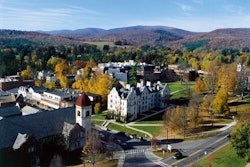The push for more representation and education about Asian identities at Amherst College has been a multi-decade affair. It’s involved protests and urging from all levels, from students to university leaders. This fall, all of that coalesces into an academic major in Asian American and Pacific Islander (AAPI) studies at Amherst.
When Dr. Pawan Dhingra first arrived on campus as a faculty member more than five years ago, conversations around wanting AAPI content were already being had, he says. He joined in.
 Dr. Pawan Dhingra
Dr. Pawan Dhingra
The hate exhibited against Asians during the COVID-19 pandemic and the Atlanta shootings of 2021 also added fuel to the fire, flaring Asian American issues into national ones.
“Then, it became a topic of conversation on campus beyond the curriculum or the field [to be] about wellbeing, safety, experiences, and the silencing of Asian Americans in a variety of ways across the country, including on campus,” he says. “All of that then helped affirm that Asian Americans themselves are a very distinct population.
“We have different experiences. You can’t collapse us into being another version of something else that already exists. We have to be understood on our own.”
This campus sentiment contributed to a bold push for AAPI studies from students, from faculty, and – with Dhingra’s eventual rise to become Amherst’s associate provost and associate dean of the faculty – from Amherst administrators.
Building the ranks
One of the biggest hurdles hindering the creation of an AAPI studies major at Amherst had been not having enough faculty to teach courses. A barebones number of faculty on the topic wouldn’t cut it. A well-run major program would need enough faculty to handle advising and senior theses loads, as well as the sufficient numbers to keep it going if someone goes on leave or temporarily can’t teach, says Dhingra.
But with rising support for such a major mounting, some at Amherst – including Dhingra and the late Dr. Franklin Odo, a famed advocate for AAPI studies – managed to put together a proposal for a cluster hire to help solve that dilemma.
The cluster hire – approved a few years ago – allowed for the school’s English, psychology, and economics departments to each hire a faculty member who would teach in their respective fields but also teach and contribute to AAPI topics. By housing the faculty in these pre-existing and prominent departments, one of the hopes is to lend a potential AAPI major more visibility, Dhingra says.
“The reason why we approached [the psychology and economics department], even though they might not be obvious in terms of what an Asian American studies curriculum should have, is because there is actually a lot of great work being done in these disciplines on Asian American issues,” he explains. “The idea here was to embed the major across multiple departments and disciplines so that all kinds of students would find ways of intersecting with it and then be exposed to it and hopefully be drawn to it.”
The faculty members would be hired as part of, and ultimately be tenured by, their separate departments. And they would be expected to teach a handful of courses that have to do with AAPI studies per academic year.
Despite not having the power to decide on the exact hires himself, Dhingra met with every candidate, he says.
Psychology hired Dr. Michelle Lee, who arrives on campus this summer. Economics faced some difficulties and plans to continue its search next school year. The English Department’s hire was Dr. Nozomi Nakaganeku Saito, now in her first year at the private Massachusetts college.
“I came from an institution that did not have an Asian American or Pacific Studies major,” says Nakaganeku Saito, a visiting assistant professor of English. “I think one of the facts of that is that it makes it so that the institution doesn’t always seem like a place or space in which students can find their own interests, footing, or community.
“I was really excited to see that student activism had led to the cluster hire and had really helped to create momentum for the creation of the major.”
Amherst’s AAPI major
With faculty number concerns nearly settled, Dhingra and his colleagues proceeded with proposing an official AAPI studies bachelor’s degree program at the school, a proposal that incorporated input from students and alumni, as well.
It was promptly and unanimously approved.
“Normally, when a proposal comes in for a new major, it gets kicked back to the people who proposed it because they have questions or things that have to get worked out. It may take a long time to get revised,” Dhingra says. “But ours went through quickly, with no real concerns.”
Core to the AAPI studies program will be four faculty members who teach, make decisions for, and help run the major. Dhingra will serve as the program’s incoming chair of the AAPI studies major. Other faculty members include Nakaganeku Saito; Dr. Edward Melillo, chair of environmental studies and the William R. Kenan, Jr. Professor of History and Environmental Studies; and Dr. Sony Coráñez Bolton, associate professor of Spanish and English and chair of Latinx and Latin American studies.
Approximately a dozen others from other academic departments, including Lee, will contribute as affiliated faculty who teach courses that serve the major, according to Dhingra.
 Dr. Nozomi Nakaganeku Saito
Dr. Nozomi Nakaganeku Saito
One of Nakaganeku Saito’s offerings this coming school year will be ENGL 291: AAPI Critiques, which will examine “tension” between Asian American identities and Pacific Islander identities, two groups that have been “differently racialized,” according to the course description.
It’s a tension – and sometimes an overshadowing of Pacific Islander concerns – that Nakaganeku Saito is very cognizant of.
“It’s May. It’s Asian American, Native Hawaiian, and Pacific Islander Heritage Month. And yet, often times the focus really becomes on Asian Americans,” Nakaganeku Saito says. “Then, even within that, there’s certain problematics of East Asians being overrepresented as the figures of Asian American identity.”
Similarly, in a March opinion piece published in the student newspaper, The Amherst Student, some of the students brought up that East Asian and Southeast Asian voices are more prominent in the course instruction they have been receiving.
Such concerns are common among Asian American studies departments across the country, Dhingra says.
“Asia is so huge that no department or major can do that,” he contends. “Having said that, we feel really great about the kind of, and diversity of, content we can deliver, not necessarily considering that we’re a small college with fewer faculty — but even almost regardless of that.
“We have courses that center some of the standard kind-of canon Asian American studies. But we also have two faculty who are core to the program who really are specialists in Pacific Islander studies. We have a lot of scholars who focus on the Philippines’ and Filipinx studies. I myself specialize in South Asian American studies.”
The content of the program’s courses will represent “a large diversity of the Asian American experience that takes place in terms of ethnicity, [sexuality, transnationalism, and class diversity],” Dhingra assures.
The path forward
For the next few years, the goal for the program is not to develop into its own academic department. Rather, it’s to make the program sustainable and solidify the particulars, such as program requirements, capstone and thesis projects, internship opportunities, and alumni connections.
Nakaganeku Saito hopes that, as the program’s curriculum evolves, it continues to bring in student input. Fields like Asian American studies and Pacific Islander studies were borne out of student activism in the 1960s and a desire to be represented in higher education, after all.
So, Amherst’s new endeavor on this topic shouldn’t be a one-way street, she argues.
In the same vein, she hopes that the major “doesn’t lose its political edge” or “critical awareness” despite now being a part of a larger institution.
“Asian American studies developed out of student radical organizing and the student protests against the war,” Nakaganeku Saito says. “The students who helped to create this major are aware of that history.
“It’s not about having a specific kind of politics, but understanding that just because this has been institutionalized, the project of liberation isn’t over.”















